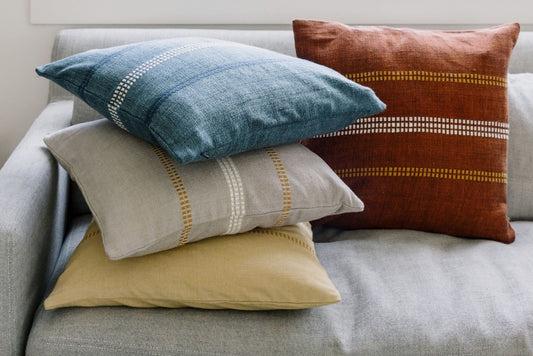In a world increasingly dominated by mass-produced goods and fast fashion, handwoven textiles stand out as symbols of authenticity, artistry, and sustainability. These fabrics, created by skilled artisans using traditional techniques passed down through generations, are more than just materials; they are stories woven in thread.
What Are Handwoven Textiles?
Handwoven textiles are fabrics produced on a loom by hand, without the use of automated machinery. The process involves interlacing warp (vertical) and weft (horizontal) threads to create a finished piece of cloth. This slow and detailed process results in textiles that are rich in character, texture, and quality.
Unlike machine-made fabrics, handwoven materials often feature subtle irregularities, which are a testament to their handmade nature and enhance their unique beauty.
The Cultural Heritage Behind Handwoven Textiles
Throughout history, cultures across the globe have developed their weaving traditions. From the colorful ikats of India to the intricate Kente cloth of Ghana, each textile tells a cultural story through its patterns, colors, and methods.
🌍 Examples from Around the World:
· India: Handloom fabrics like khadi and jamdani are known for their softness and breathability.
· Guatemala: Mayan backstrap weaving produces vibrant, symbolic patterns.
· Morocco: Handwoven wool rugs such as Beni Ourain are prized for their geometric simplicity.
· Peru: Andean weavers use natural alpaca fibers dyed with plant-based pigments to create stunning designs.
When you purchase handwoven textiles, you're not just buying fabric — you're supporting the continuation of these cultural heritages and helping preserve artisan livelihoods.
Sustainability Benefits of Handwoven Textiles
In an age of climate concern and environmental responsibility, handwoven textiles offer a greener alternative to factory-made goods.
♻️ 1. Low Carbon Footprint
Handweaving uses significantly less energy than industrial textile production, as it doesn’t rely on electricity-intensive machines or large-scale manufacturing processes.
🌿 2. Natural Fibers
Most handwoven textiles are crafted using sustainable fibers such as organic cotton, wool, jute, or bamboo. These materials are biodegradable, renewable, and often grown without harmful chemicals.
🚫 3. Minimal Waste
Handweaving is done in small batches or custom orders, resulting in less textile waste compared to mass-produced garments and home goods.
🧵 4. Ethical Production
Purchasing handwoven products typically supports artisan communities directly, promoting fair wages, safe working conditions, and the empowerment of local craftspeople, often women.
How to Use Handwoven Textiles in Your Lifestyle
Whether you're updating your wardrobe, refreshing your home decor, or looking for thoughtful gifts, handwoven textiles add richness and depth to any setting.
🏡 For Home Decor
· Throw Blankets: Drape a handwoven cotton or wool throw over your couch for a cozy, artisanal touch.
· Table Linens: Use handwoven runners, napkins, or placemats for a rustic and elegant dining experience.
· Pillows and Upholstery: Add texture and color with handwoven cushion covers or even reupholster furniture with artisan fabrics.
· Curtains: Lightweight handwoven cotton or linen curtains provide breathability and a breezy, natural look.
👗 For Fashion
· Scarves and Shawls: Elevate a simple outfit with a handwoven wrap made from silk, cotton, or wool.
· Tops and Dresses: Many ethical fashion brands offer limited collections using handwoven fabrics for unique, slow-fashion garments.
· Bags and Accessories: Find handbags or wallets crafted from woven materials like hemp or recycled sari yarns.
How to Identify Authentic Handwoven Textiles
To ensure you're investing in real handwoven goods and not mass-produced imitations, here are a few things to look for:
· Subtle Irregularities: Minor variations in texture or weave indicate a human touch.
· Selvage Edges: True handwoven fabric often has clean, finished edges that don’t fray.
· Labeling: Reputable artisans or brands typically label their products as “handwoven,” “handloom,” or “artisan-made.”
· Certifications: Look for fair-trade or craft-based certifications from ethical organizations.
Caring for Handwoven Textiles
To prolong the life of your handwoven items:
· Gentle Wash: Handwash in cold water using mild detergent or machine-wash on a delicate cycle (check care instructions).
· Avoid Bleach: Harsh chemicals can weaken natural fibers.
· Air Dry: Lay flat or hang to dry away from direct sunlight to prevent fading.
· Store Safely: Fold and store in a cool, dry place. Use cotton bags to avoid moisture and moth damage.
Where to Buy Handwoven Textiles
If you’re ready to embrace the warmth and authenticity of handwoven textiles, explore:
· Etsy: A global marketplace for independent weavers and textile artisans.
· Local Artisan Markets: Support craftspeople in your community.
· Fair-Trade Stores: Brands like Ten Thousand Villages, Maiyet, and Indigenous promote handmade, ethical goods.
· Boutique Online Retailers: Look for brands committed to slow fashion and sustainability.
Final Thoughts
Handwoven textiles are more than just beautiful materials — they’re a celebration of craftsmanship, culture, and conscious living. By choosing handwoven over machine-made, you're embracing quality, sustainability, and a connection to tradition that enriches both your home and your values.



